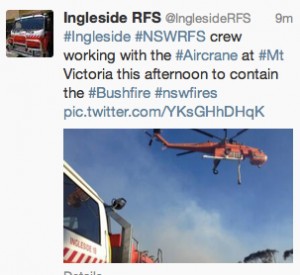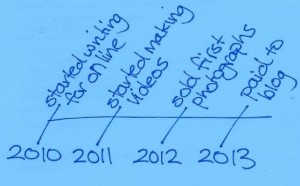Search Results for Tag: Interactive
Interactive and social media documenting Australian bushfires
 The extensive bushfires in the Australian state of New South Wales have made global headlines in the past week.
The extensive bushfires in the Australian state of New South Wales have made global headlines in the past week.
Social media, particularly via the Twitter hashtag #nswfires, is serving as a way for media and emergency services to post updates, but also for users in fire affected areas to document and share information, experiences and photos.
A number of bushfire photos also went viral via social media. For example this shot of exhausted firefighters resting on a road.
https://twitter.com/theage_photo/status/391186566095196160
On YouTube, this helmet camera footage posted by the Blackheath – Mt Victoria Rural Fire Brigade shows the extreme conditions firefighters are facing.
Australia’s public broadcaster, ABC, plays an important role during natural disasters and emergencies such as bushfires, to keep communities accurately informed – particularly through their local radio network.
That’s a huge media development topic to explore on its own, particularly for national media networks in developing countries seeking a model for informing and communicating with audiences during natural disasters.
For now though, what caught onMedia’s eye was the ABC’s use of tools such as Storify and ThingLink to help visualize stories on their live bushfire blog.
![]() read more
read more
Tools and Apps for Journalists: ThingLink
What is ThingLink?
 Add extra layers of information to images by adding links.
Add extra layers of information to images by adding links.
Thinglink lets you embed “tags” – hyperlinks and text – into images. If you have a great photograph or image you can add a link to another photo, or a website, or video clip, or audio clip – literally anything. It’s a very useful tool for creating simple pieces of interactive media to compliment a story or to use as a basic story platform. This tool is always a winner with participants in online journalism workshops. As we roll our mouse over a “tag” revealing a link to another piece of media, there is usually a collective “Aha!” from participants. And if you’re a regular reader of onMedia, you’ve probably noticed that we like to use this tool a lot.
In a much cited example here in Germany, the Berliner Morgenpost used ThingLink very effectively with a photograph of the White House Situation Room during the raid on Osama bin Laden’s hideout. The icons identify who was in the room and provide relevant links.
![]() read more
read more
Tools and Apps for Journalists: TimelineJS
 Timelines arrange events in chronological order. From learning about dinosaurs or the order of kings and queens at school, at some stage you would have stumbled over a timeline. The point of a timeline is to make it easier to understand when things happened.
Timelines arrange events in chronological order. From learning about dinosaurs or the order of kings and queens at school, at some stage you would have stumbled over a timeline. The point of a timeline is to make it easier to understand when things happened.
There are plenty of Internet tools to help you create a timeline, but one tool that is popular with media organizations is TimelineJS.
What is TimelineJS?
 TimelineJS (Java Script) lets you easily link to different multimedia sources. So as well as text, you can include videos from YouTube and Vimeo, audio from SoundCloud, photos from Flickr, Tweets, Googlemaps and Wikipedia entries and more. Scribd is also useful for including text documents.
TimelineJS (Java Script) lets you easily link to different multimedia sources. So as well as text, you can include videos from YouTube and Vimeo, audio from SoundCloud, photos from Flickr, Tweets, Googlemaps and Wikipedia entries and more. Scribd is also useful for including text documents.
Other media are regularly added so check with the TimelineJS website to see what else they support.
As a result, TimelineJS makes it easy to visually show events and the interactivity means users can explore further if they want to.
![]() read more
read more
Aron Pilhofer: ‘You have to put priority on digital’
The New York Times has long served as a example of a media organization that is successfully combining digital technologies with high-quality journalism. From the Pulitzer prize-winning, multimedia story Snow Fall, which has generated more than 3.5 million page views, to its paywall subscription model, many are looking to the prestigious institution for answers on how to survive the digital future. But the New York Times is also still experimenting. “We don’t know what is best practice,” says Aron Pilhofer, one of the best digital minds at the news organization.
Pilhofer is head of the social media team, communities team and interactive news team, which employs journalists as well as programmers and data experts (follow Pilhofer on Twitter). He recently has a new team to manage – the newsroom analytics team which aims to better understand how content is consumed. In an interview with DW Akademie’s Steffen Leidel, Pilhofer explains his hopes for the new team, the lessons he has learned from past mistakes and the challenges facing future generations of journalists.
![]() read more
read more





Feedback